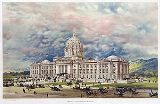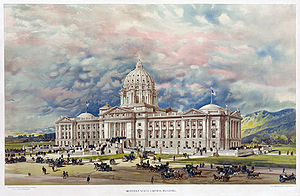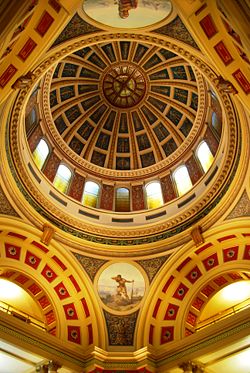
Montana State Capitol
Encyclopedia
The Montana State Capitol is the state capitol of the U.S. state
of Montana
. It houses the Montana State Legislature
and is located in the state capital of Helena
at 1301 East Sixth Avenue. The building was constructed between 1896 and 1902 with wing-annexes added between 1909 and 1912.
 A design competition
A design competition
for the building was conducted in 1896. The commission selected a design by George R. Mann
as the winner. In 1897, after it was found that the Commission was planning to scam money from the building project, it was disbanded and a second Capitol Commission was convened. The new Commission abandoned Mann's plan as being too costly, and had a second design competition, won by Charles Emlen Bell and John Hackett Kent. While Mann's building was never built in Montana, it was selected later as the basic design for the Arkansas State Capitol
.
The winning design by Bell and Kent had been altered already during the construction phase, when in 1901 the commission asked for the structure to be made more imposing by increasing the height of the dome. Kent opposed the changes, as his original low spherical dome was meant to be "pure Greek", but Bell advocated the commission's request. Between 1909-12 the building has been extended by addition of two new wings on the eastern and western sides.
and granite
, is in Greek
neoclassical
architectural style
, and is listed on the National Register of Historic Places
. The exterior of the dome is covered with copper. Atop the dome is a feminine statue affectionately dubbed "Lady Liberty
."
 The most notable feature inside the center of the Capitol building is the massive rotunda
The most notable feature inside the center of the Capitol building is the massive rotunda
, with four circular paintings surrounding it. These paintings, were painted for the Capitol opening in 1902 by the firm of F. Pedretti's Sons, depict four important archetypes of people of Montana's early history: a native American (intended to be of Chief Charlo
), an explorer and fur trapper (Jim Bridger
), a gold miner (Henry Finnis Edgar, one of the discoverers of gold at Alder Gulch
), and a cowboy (unidentified, but said to be inspired by the works of C.M. Russell
). The Pendretti brothers provided additional commissioned artwork in the Senate and Old Supreme Court Chambers.
The western arch of the rotunda features the semi-elliptical painting "Driving The Golden Spike", painted by Amedee Joullin. The former State Law Library, now a set of committee rooms, features ten Montana landscapes created by Ralph E. DeCamp. The House of Representatives Lobby features six scenes depicting significant events in early Montana History by Edgar S. Paxson
.
The most significant piece of art in the Capitol is by Montana's famous Western artist Charles M. Russell. The 1912 painting, titled Lewis and Clark Meeting the Flathead Indians at Ross' Hole, is 25 feet (7.6 m) long and twelve feet high. It depicts the explorers Lewis and Clark
meeting Montana's Bitterroot Salish people upon their return across the Bitterroot Mountains
from the Pacific Ocean
. It is now displayed above the Speaker's chair in the House of Representatives' chamber.
U.S. state
A U.S. state is any one of the 50 federated states of the United States of America that share sovereignty with the federal government. Because of this shared sovereignty, an American is a citizen both of the federal entity and of his or her state of domicile. Four states use the official title of...
of Montana
Montana
Montana is a state in the Western United States. The western third of Montana contains numerous mountain ranges. Smaller, "island ranges" are found in the central third of the state, for a total of 77 named ranges of the Rocky Mountains. This geographical fact is reflected in the state's name,...
. It houses the Montana State Legislature
Montana State Legislature
The Montana State Legislature is the state legislature of the U.S. state of Montana. It is composed of the 100-member Montana House of Representatives and the 50-member Montana Senate....
and is located in the state capital of Helena
Helena, Montana
Helena is the capital city of the U.S. state of Montana and the county seat of Lewis and Clark County. The 2010 census put the population at 28,180. The local daily newspaper is the Independent Record. The Helena Brewers minor league baseball and Helena Bighorns minor league hockey team call the...
at 1301 East Sixth Avenue. The building was constructed between 1896 and 1902 with wing-annexes added between 1909 and 1912.
History

Architectural design competition
An architectural design competition is a special type of competition in which an organization or government body that plans to build a new building asks for architects to submit a proposed design for a building. The winning design is usually chosen by an independent panel of design professionals...
for the building was conducted in 1896. The commission selected a design by George R. Mann
George R. Mann
George Richard Mann was a United States architect whose designs included the Arkansas State Capitol...
as the winner. In 1897, after it was found that the Commission was planning to scam money from the building project, it was disbanded and a second Capitol Commission was convened. The new Commission abandoned Mann's plan as being too costly, and had a second design competition, won by Charles Emlen Bell and John Hackett Kent. While Mann's building was never built in Montana, it was selected later as the basic design for the Arkansas State Capitol
Arkansas State Capitol
The Arkansas State Capitol Building, located in Little Rock, is the main house of government of the state of Arkansas.-History:In 1899, the St. Louis architect George R. Mann visited the governor of Arkansas Daniel W. Jones, and presented his drawings of his winning competition design for the...
.
The winning design by Bell and Kent had been altered already during the construction phase, when in 1901 the commission asked for the structure to be made more imposing by increasing the height of the dome. Kent opposed the changes, as his original low spherical dome was meant to be "pure Greek", but Bell advocated the commission's request. Between 1909-12 the building has been extended by addition of two new wings on the eastern and western sides.
Architecture
The building, constructed of Montana sandstoneSandstone
Sandstone is a sedimentary rock composed mainly of sand-sized minerals or rock grains.Most sandstone is composed of quartz and/or feldspar because these are the most common minerals in the Earth's crust. Like sand, sandstone may be any colour, but the most common colours are tan, brown, yellow,...
and granite
Granite
Granite is a common and widely occurring type of intrusive, felsic, igneous rock. Granite usually has a medium- to coarse-grained texture. Occasionally some individual crystals are larger than the groundmass, in which case the texture is known as porphyritic. A granitic rock with a porphyritic...
, is in Greek
Architecture of Ancient Greece
The architecture of Ancient Greece is the architecture produced by the Greek-speaking people whose culture flourished on the Greek mainland and Peloponnesus, the Aegean Islands, and in colonies in Asia Minor and Italy for a period from about 900 BC until the 1st century AD, with the earliest...
neoclassical
Neoclassical architecture
Neoclassical architecture was an architectural style produced by the neoclassical movement that began in the mid-18th century, manifested both in its details as a reaction against the Rococo style of naturalistic ornament, and in its architectural formulas as an outgrowth of some classicizing...
architectural style
Architectural style
Architectural styles classify architecture in terms of the use of form, techniques, materials, time period, region and other stylistic influences. It overlaps with, and emerges from the study of the evolution and history of architecture...
, and is listed on the National Register of Historic Places
National Register of Historic Places
The National Register of Historic Places is the United States government's official list of districts, sites, buildings, structures, and objects deemed worthy of preservation...
. The exterior of the dome is covered with copper. Atop the dome is a feminine statue affectionately dubbed "Lady Liberty
Lady Liberty
Lady Liberty may refer to:* Lady Liberty , La mortadella, 1972 French-Italian comedy* "Lady Liberty" , written by Al Jardine and Ron Altbach for the Beach Boys...
."
Art

Rotunda (architecture)
A rotunda is any building with a circular ground plan, sometimes covered by a dome. It can also refer to a round room within a building . The Pantheon in Rome is a famous rotunda. A Band Rotunda is a circular bandstand, usually with a dome...
, with four circular paintings surrounding it. These paintings, were painted for the Capitol opening in 1902 by the firm of F. Pedretti's Sons, depict four important archetypes of people of Montana's early history: a native American (intended to be of Chief Charlo
Chief Charlo
Chief Charlo lived from 1830-1910 in the Bitterroot Valley and served as head chief of the Bitterroot Salish from 1870 to 1910. He was appointed chief upon death of his father, Chief Victor . Chief Victor was a principal signer of the Treaty of Hellgate in 1855...
), an explorer and fur trapper (Jim Bridger
Jim Bridger
James Felix "Jim" Bridger was among the foremost mountain men, trappers, scouts and guides who explored and trapped the Western United States during the decades of 1820-1850, as well as mediating between native tribes and encroaching whites...
), a gold miner (Henry Finnis Edgar, one of the discoverers of gold at Alder Gulch
Alder Gulch
Alder Gulch is a place in the U.S. state of Montana, where gold was discovered on May 26, 1863 by William Fairweather and a group of men, including Barney Hughes, Thomas Cover, Henry Rodgers, Henry Edgar and Bill Sweeney who were returning to the gold fields of Bannack, Montana...
), and a cowboy (unidentified, but said to be inspired by the works of C.M. Russell
Charles Marion Russell
Charles Marion Russell , also known as C. M. Russell, Charlie Russell, and "Kid" Russell, was an artist of the Old American West. Russell created more than 2,000 paintings of cowboys, Indians, and landscapes set in the Western United States, in addition to bronze sculptures...
). The Pendretti brothers provided additional commissioned artwork in the Senate and Old Supreme Court Chambers.
The western arch of the rotunda features the semi-elliptical painting "Driving The Golden Spike", painted by Amedee Joullin. The former State Law Library, now a set of committee rooms, features ten Montana landscapes created by Ralph E. DeCamp. The House of Representatives Lobby features six scenes depicting significant events in early Montana History by Edgar S. Paxson
Edgar Samuel Paxson
Edgar Samuel Paxson was an American frontier painter, scout, soldier and writer, based mainly in Montana. He is best known for his portraits of Native Americans in the Old West and for his depiction of the Battle of Little Bighorn in his painting "Custer's Last Stand".- Biography :Paxson was born...
.
The most significant piece of art in the Capitol is by Montana's famous Western artist Charles M. Russell. The 1912 painting, titled Lewis and Clark Meeting the Flathead Indians at Ross' Hole, is 25 feet (7.6 m) long and twelve feet high. It depicts the explorers Lewis and Clark
Lewis and Clark Expedition
The Lewis and Clark Expedition, or ″Corps of Discovery Expedition" was the first transcontinental expedition to the Pacific Coast by the United States. Commissioned by President Thomas Jefferson and led by two Virginia-born veterans of Indian wars in the Ohio Valley, Meriwether Lewis and William...
meeting Montana's Bitterroot Salish people upon their return across the Bitterroot Mountains
Bitterroot Mountains
The Northern and Central Bitterroot Range, collectively the Bitterroot Mountains, is the largest portion of the Bitterroot Range, part of the Rocky Mountains, located in the panhandle of Idaho and westernmost Montana in the Western United States...
from the Pacific Ocean
Pacific Ocean
The Pacific Ocean is the largest of the Earth's oceanic divisions. It extends from the Arctic in the north to the Southern Ocean in the south, bounded by Asia and Australia in the west, and the Americas in the east.At 165.2 million square kilometres in area, this largest division of the World...
. It is now displayed above the Speaker's chair in the House of Representatives' chamber.

